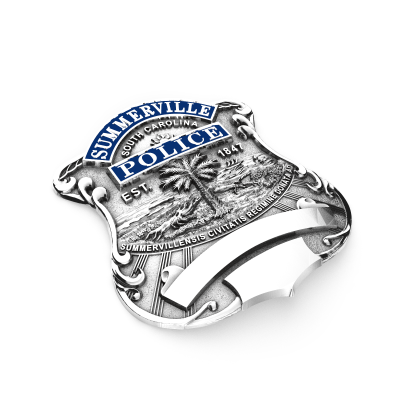How do weather and climate impact your metal badge?
Protect your metal badge from exposure to air and the elements.

If you wear a metal badge on your public safety uniform, it's essential to understand how exposure to weather elements— humidity, rain, salt, and even air itself—can affect its long-term durability. In this article, we'll explore the impact of climate and weather on the appearance of your badge, differentiating between electroplated and non-plated badges.
Electroplated vs. Non-Plated Badges: What’s the difference?
Before delving into the effects of climate and weather, we must first distinguish between electroplated "plated" and non-plated badges. Regardless of type, all high-quality badges are crafted from solid brass—an alloy primarily composed of copper and zinc. Solid brass is excellent for badge manufacturing because it is malleable and can be polished to a high luster.
An electroplated “plated” badge is made of solid brass and then encapsulated in a protective nickel layer. This nickel layer is applied using a method called electroplating. The primary purpose of the nickel layer is to protect the brass, but it is also decorative. If a badge is “non-plated” this means that it is not electroplated and therefore does not have the protective nickel layer applied over the brass. Instead, a non-plated badge will be protected by an applied clear coating.
Let’s start with the weather:
Hot, cold, windy, or rainy, one thing in common with all weather is “air.” When brass is exposed to air it reacts with the oxygen, salt, and humidity (water) in the air to form brown-black spots (tarnish) and/or green spots (patina) on the surface. The brown-black spots are the result of brass coming in contact with oxygen. The green spots are the result of contact between brass and the carbon or sulfur dioxides in the air. High levels of humidity in the air accelerate the reactions.
The clear coating on a non-plated badge is critical to prevent direct contact between the brass and the air, but when it wears off, the brass surface of the badge is exposed to the air causing it to tarnish and/or patina. The tarnish and/or patina can be removed only by polishing the top layer of metal off the badge. Unless a high-quality clear coating is re-applied, the tarnish will come back even quicker. Additionally, as layers of metal are removed through polishing so are some of the fine details in the badge.
Exposure to air is where electroplated badges have a significant advantage over non-plated badges. The purpose of electroplating is to encapsulate a reactive metal so that it does not tarnish or patina. Electroplating the badge nearly eliminates the impact of the oxygen, salt, and humidity in the air from damaging your badge.
Let’s move on to climate:
With an understanding of how the weather impacts the surface of your badge, you can imagine that your local climate should be a consideration when deciding on a finish for your badge. If you work in a wet and humid place, such as the Atlantic Coast or Southeastern United States the formation of tarnish/patina on brass is going to be accelerated by the climate. If you work in a warm and dry climate, such as the Southwestern United States, the tarnish/patina will form more gradually and be less of a concern.
Conclusion:
Weather and climate are important considerations when choosing a finish for your badge. If you are considering a non-plated badge, then it is important to make sure it has a strong clear coating and you should be prepared to polish/refinish it often in most climates. Unless you live in a warm and very dry climate, such as the Southwestern United States, you will be better served with an electroplated badge because it will be better protected against the effects of weather and climate.
At Smith & Warren, all of our finishes begin with electroplating as a protective coating. On our deluxe finishes, we go a step further by also applying a baked clear coating to further protect it from abrasion.
If you have further questions about this article or general questions about badges, contact us at Smith & Warren—we're here to help.



